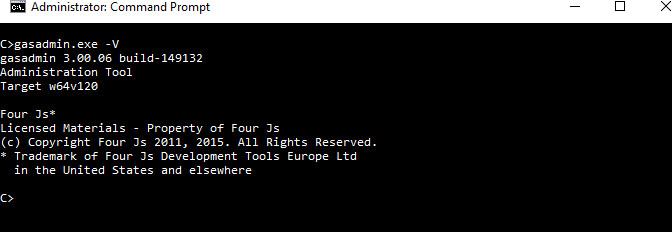The gasadmin tool is provided as an administrative command for the Genero Application Server.
- Display GAS version information, see Display GAS version.
- Specify the GAS application directory, see Specify GAS directory
- List all sessions of a specified dispatcher, see List sessions
- Stop dispatcher sessions, see Kill sessions
- Validate the GAS configuration, see Validating with the gasadmin tool
- Explode the GAS configuration, see Explode configuration file
- Ping dispatchers active sessions, see Ping active sessions
- Manage archive files, see Genero Archive procedures
- Reset the log output for a session. See Reset logs
- Retrieve information to monitor a session. See Monitor session
Syntax
gasadmin [options]
Syntax with reset-log command
gasadmin reset-log [options ] [session-id ...]
Options
| Option | Description |
|---|---|
|
-p directory --as-directory directory |
Specify the Genero Application Server directory. |
|
-f configuration-file --configuration-file configuration-file |
Specify the configuration file to use. If not specified, the default configuration file, FGLASDIR/etc/as.xcf, is used. |
|
-E resourceName=value --resource-overwrite resourceName=value |
Define or overwrite a resource. Important: If you start the dispatcher with the option
(-E) to override the $(res.appdata.path) location, you
must also override the resource when using the gasadmin command to deploy
an archive.
For example, specify the same option with both commands:
|
|
-c --configuration-check |
Check the configuration file, then exit. |
|
-e --configuration-explode |
Explode the GAS configuration into files, one for each application. |
|
-t --configuration-explode-external |
Explode the given external configuration file in current directory. See Explode configuration file into an XML file |
|
-r --configuration-expand-resources |
Expand resources and replace with real values. Used with --configuration-explode or --configuration-explode-external. See Explode configuration file into XML files |
|
-d dispatcher-name --dispatcher dispatcher-name |
Used by session-related options to select the target dispatcher. |
|
-K -d dispatcher-name --kill-all-sessions --kill-all-sessions --dispatcher dispatcher-name |
Terminate (kill) all sessions of a specified
dispatcher. Note: The option -d
<dispatcher_name> is optional. If omitted, the option kills all sessions
of all dispatchers.
|
|
-k session-id -d dispatcher-name --kill-session session-id --dispatcher dispatcher-name |
Terminate (kill) the requested
session id of the specified dispatcher. Important: The option -d
<dispatcher_name> is required, as the same session identifier
can exist for the various dispatchers.
See Kill dispatcher sessions |
|
-X -X -d dispatcher-name --ping-all-sessions --ping-all-sessions --dispatcher dispatcher-name |
Ping all active sessions of the
specified dispatcher. Note: The option -d
<dispatcher_name> is
optional. If omitted, the option pings all active sessions of all dispatchers.
|
|
-x session-id -d dispatcher-name --ping-session session-id --dispatcher dispatcher-name |
Ping the request session id of the specified dispatcher. |
|
-l -l -d dispatcher-name --list-sessions --list-sessions --dispatcher dispatcher-name |
List all sessions of the specified
dispatcher. Note: The option -d
<dispatcher_name> is optional.
If omitted, the option lists all sessions of all dispatchers.
See List dispatcher sessions |
|
--dispatcher dispatcher-name --monitorsession-id |
Retrieve monitor information for a session.
Information is displayed in XML format on the standard output. See Monitor session. Note: Monitor feature was added in
3.00 (MR) maintenance release.
|
-z paths, [...] --compress-resources paths, [...] |
Compress the resources located in specified paths. The path separator is a comma (,). See Compress resources. |
-C --session-cleanup |
Clear remaining Linux®/UNIX™ domain sockets. |
|
-h --help |
Display help information. |
|
-V --version |
Display GAS version information. See Display GAS version information |
|
-q --quiet |
Silent mode. |
|
--deploy-archive archive_file |
Unpack the specified archive content into the deployment directory. |
|
--undeploy-archive archive_file |
Undeploy the specified archive. |
|
--enable-archive archive_file |
Expose all services and applications contained in the specified archive. |
|
--disable-archive archive_file |
Unexpose all services and applications contained in the specified archive. |
|
--list-archives |
List all archives deployed on the Genero Application Server. |
|
--clean-archives |
Clean up all undeployed archives. |
| --xml-output | List all archives and applications deployed on the Genero Application Server. Only compatible with archive options. |
|
-y --yes |
Do not prompt for confirmation. |
| --monitor | Retrieve monitor information for a session. Information is displayed in XML format on the standard output. See Monitor session. |
| Option | Description |
|---|---|
| -h --help |
Displays help for the reset-log command. |
| -q --quiet |
Operates in silent mode |
| -p
directory_name
--as-directory directory_name |
Specify the Genero Application Server directory. |
| -f
configuration-file --configuration-fileconfiguration_file_name |
Specify the configuration file to use. If not specified, the default configuration file, FGLASDIR/etc/as.xcf, is used. |
|
-E resource_name=value --resource-overwrite resource_name=value |
Define or overwrite a resource. |
|
-d dispatcher-name --dispatcher dispatcher_name |
Target the dispatcher - used by session-related options to select the target dispatcher. |
|
--output-type <arg> |
Log type (CONSOLE or DAILYFILE), default is DAILYFILE. |
|
--output-path <arg> |
Log output directory for DAILYFILE, default is the current directory. |
|
--raw-data-max-length <arg> |
Data max length, default is -1. |
|
--format <arg> |
Log format, columns to output, the default is: time event-type event-params. |
|
--categories <arg> |
Log categories to enable, the default is: GAS ACCESS PROCESS ERROR |
Usage Examples
Explode configuration file into an XML file
gasadmin -t demo/Card
Explode configuration file into XML files
gasadmin -r -t demo/Card
List dispatcher sessions
gasadmin -X -f as1.xcf -d httpdispatch
Kill dispatcher sessions
gasadmin -k d98290172c8f7c0d861db329f1ce6597 -f as1.xcf -d isapidispatch
Monitor session
gasadmin --dispatcher <dispatcher> --monitor <session-id>The -d or --dispatcher option is required to specify the dispatcher.
Compress resources
gasadmin -z FGLASDIR/app,$FGLASDIR/services,$FGLASDIR/web, FGLASDIR/tpl
Reset logs
gasadmin reset-log --output-type CONSOLE --categories "ALL DEBUG" 1170f560ca4d03fd3aa4bbac75da97e9
If an option (for example, --output_path) is not specified, gasadmin tries to use the LOG configuration from the as.xcf. If not found in the as.xcf (for example, CONSOLE may not be configured in as.xcf), default values are used.
Display GAS version information
gasadmin -V

Figure 1. Sample GAS Version Information